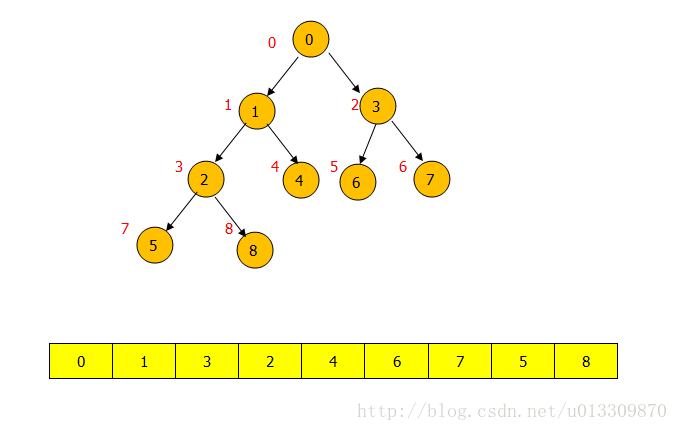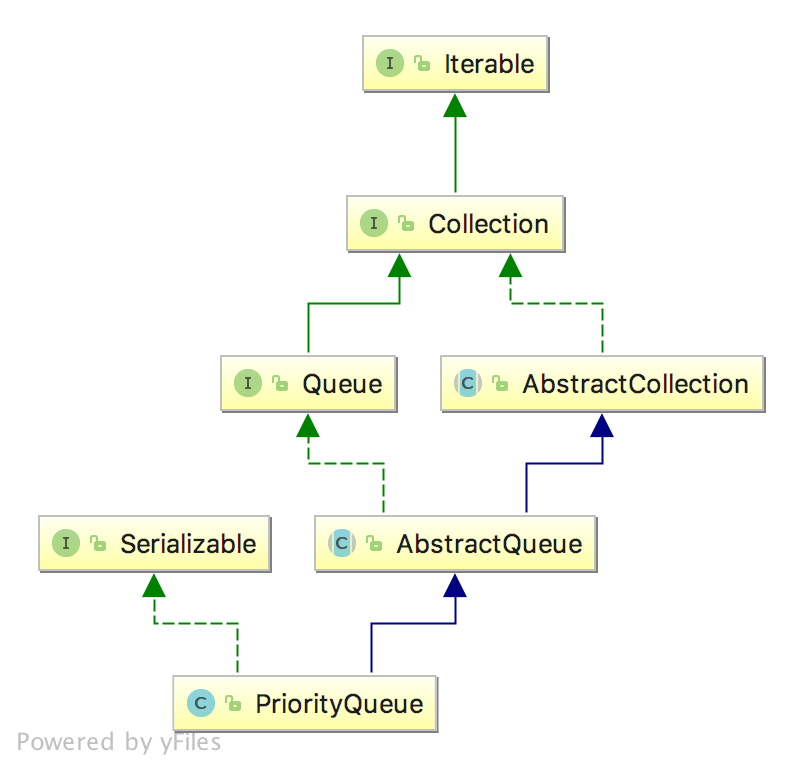开篇
PriorityQueue是具备了小根堆性质的数据结构也就是优先队列PriorityQueue,内部实现是一个堆排序的数据结构。
PriorityQueue的逻辑结构是一棵完全二叉树,存储结构其实是一个数组。逻辑结构层次遍历的结果刚好是一个数组,如下图。
PriorityQueue类图
PriorityQueue类变量和构造函数
PriorityQueue的类变量当中包含存储元素的数组queue和用于排序的比较器comparator。
PriorityQueue的构造函数参数中包含存储数组的大小initialCapacity和比较器comparator。
PriorityQueue的构造函数针对传入为Collection的对象的时候会依据是否已经排好序进行初始化,针对无序的集合通过heapify进行堆序的构建。
public class PriorityQueue<E> extends AbstractQueue<E>
implements java.io.Serializable {
private static final long serialVersionUID = -7720805057305804111L;
// 初始化容量大小
private static final int DEFAULT_INITIAL_CAPACITY = 11;
// 数据存储数组
transient Object[] queue; // non-private to simplify nested class access
private int size = 0;
// 容器比较器
private final Comparator<? super E> comparator;
transient int modCount = 0; // non-private to simplify nested class access
public PriorityQueue() {
this(DEFAULT_INITIAL_CAPACITY, null);
}
public PriorityQueue(int initialCapacity) {
this(initialCapacity, null);
}
public PriorityQueue(Comparator<? super E> comparator) {
this(DEFAULT_INITIAL_CAPACITY, comparator);
}
public PriorityQueue(int initialCapacity,
Comparator<? super E> comparator) {
// Note: This restriction of at least one is not actually needed,
// but continues for 1.5 compatibility
if (initialCapacity < 1)
throw new IllegalArgumentException();
this.queue = new Object[initialCapacity];
this.comparator = comparator;
}
public PriorityQueue(Collection<? extends E> c) {
if (c instanceof SortedSet<?>) {
SortedSet<? extends E> ss = (SortedSet<? extends E>) c;
this.comparator = (Comparator<? super E>) ss.comparator();
initElementsFromCollection(ss);
}
else if (c instanceof PriorityQueue<?>) {
PriorityQueue<? extends E> pq = (PriorityQueue<? extends E>) c;
this.comparator = (Comparator<? super E>) pq.comparator();
initFromPriorityQueue(pq);
}
else {
this.comparator = null;
initFromCollection(c);
}
}
@SuppressWarnings("unchecked")
public PriorityQueue(PriorityQueue<? extends E> c) {
this.comparator = (Comparator<? super E>) c.comparator();
initFromPriorityQueue(c);
}
@SuppressWarnings("unchecked")
public PriorityQueue(SortedSet<? extends E> c) {
this.comparator = (Comparator<? super E>) c.comparator();
initElementsFromCollection(c);
}
private void initFromPriorityQueue(PriorityQueue<? extends E> c) {
if (c.getClass() == PriorityQueue.class) {
this.queue = c.toArray();
this.size = c.size();
} else {
initFromCollection(c);
}
}
private void initElementsFromCollection(Collection<? extends E> c) {
Object[] a = c.toArray();
// If c.toArray incorrectly doesn't return Object[], copy it.
if (a.getClass() != Object[].class)
a = Arrays.copyOf(a, a.length, Object[].class);
int len = a.length;
if (len == 1 || this.comparator != null)
for (int i = 0; i < len; i++)
if (a[i] == null)
throw new NullPointerException();
this.queue = a;
this.size = a.length;
}
private void initFromCollection(Collection<? extends E> c) {
initElementsFromCollection(c);
heapify();
}
}
PriorityQueue的add操作
PriorityQueue的add操作主要是在offer()函数当中,整体执行逻辑如下:
判断数组大小并通过grow进行扩容:
- 如果数组为为空则第一个加入元素就直接添加。
- 如果数组不为空则添加元素到末尾并通过siftUp上浮元素到合适的位置。
- 上浮的过程就是堆排序的过程的,通过和父节点进行比较继而上浮。
public boolean add(E e) {
return offer(e);
}
public boolean offer(E e) {
if (e == null)
throw new NullPointerException();
modCount++;
//这里原来size大小就是新增元素后的最后一个元素下标
int i = size;
if (i >= queue.length)
grow(i + 1);
size = i + 1;
if (i == 0)
queue[0] = e;
else
siftUp(i, e);
return true;
}
private void grow(int minCapacity) {
int oldCapacity = queue.length;
// Double size if small; else grow by 50%
int newCapacity = oldCapacity + ((oldCapacity < 64) ?
(oldCapacity + 2) :
(oldCapacity >> 1));
// overflow-conscious code
if (newCapacity - MAX_ARRAY_SIZE > 0)
newCapacity = hugeCapacity(minCapacity);
queue = Arrays.copyOf(queue, newCapacity);
}
private void siftUp(int k, E x) {
if (comparator != null)
siftUpUsingComparator(k, x);
else
siftUpComparable(k, x);
}
@SuppressWarnings("unchecked")
private void siftUpComparable(int k, E x) {
Comparable<? super E> key = (Comparable<? super E>) x;
while (k > 0) {
int parent = (k - 1) >>> 1;
Object e = queue[parent];
if (key.compareTo((E) e) >= 0)
break;
queue[k] = e;
k = parent;
}
queue[k] = key;
}
@SuppressWarnings("unchecked")
private void siftUpUsingComparator(int k, E x) {
while (k > 0) {
int parent = (k - 1) >>> 1;
Object e = queue[parent];
if (comparator.compare(x, (E) e) >= 0)
break;
queue[k] = e;
k = parent;
}
queue[k] = x;
}
private void siftDown(int k, E x) {
if (comparator != null)
siftDownUsingComparator(k, x);
else
siftDownComparable(k, x);
}
PriorityQueue的remove操作
PriorityQueue的remove操作主要过程有两个过程:
- 通过遍历数组找到对应的下标index。
- 将最后一个元素和index节点的左右子节点进行比较然后下沉到合适的位置。
- 最后一个元素设置为null即可。
private int indexOf(Object o) {
if (o != null) {
for (int i = 0; i < size; i++)
if (o.equals(queue[i]))
return i;
}
return -1;
}
public boolean remove(Object o) {
int i = indexOf(o);
if (i == -1)
return false;
else {
removeAt(i);
return true;
}
}
private E removeAt(int i) {
// assert i >= 0 && i < size;
modCount++;
int s = --size;
if (s == i) // removed last element
queue[i] = null;
else {
E moved = (E) queue[s];
queue[s] = null;
siftDown(i, moved);
if (queue[i] == moved) {
siftUp(i, moved);
if (queue[i] != moved)
return moved;
}
}
return null;
}
private void siftDown(int k, E x) {
if (comparator != null)
siftDownUsingComparator(k, x);
else
siftDownComparable(k, x);
}
@SuppressWarnings("unchecked")
private void siftDownComparable(int k, E x) {
Comparable<? super E> key = (Comparable<? super E>)x;
int half = size >>> 1; // loop while a non-leaf
while (k < half) {
int child = (k << 1) + 1; // assume left child is least
Object c = queue[child];
int right = child + 1;
if (right < size &&
((Comparable<? super E>) c).compareTo((E) queue[right]) > 0)
c = queue[child = right];
if (key.compareTo((E) c) <= 0)
break;
queue[k] = c;
k = child;
}
queue[k] = key;
}
@SuppressWarnings("unchecked")
private void siftDownUsingComparator(int k, E x) {
int half = size >>> 1;
while (k < half) {
int child = (k << 1) + 1;
Object c = queue[child];
int right = child + 1;
if (right < size &&
comparator.compare((E) c, (E) queue[right]) > 0)
c = queue[child = right];
if (comparator.compare(x, (E) c) <= 0)
break;
queue[k] = c;
k = child;
}
queue[k] = x;
}
PriorityQueue的heapify操作
PriorityQueue的堆构造过程递归的执行从(n/2-1)至0递归进行构建,这个过程可以参考java源码-PriorityBlockingQueue的构建过程。
。
private void heapify() {
for (int i = (size >>> 1) - 1; i >= 0; i--)
siftDown(i, (E) queue[i]);
}
private void siftDown(int k, E x) {
if (comparator != null)
siftDownUsingComparator(k, x);
else
siftDownComparable(k, x);
}
@SuppressWarnings("unchecked")
private void siftDownComparable(int k, E x) {
Comparable<? super E> key = (Comparable<? super E>)x;
int half = size >>> 1; // loop while a non-leaf
while (k < half) {
int child = (k << 1) + 1; // assume left child is least
Object c = queue[child];
int right = child + 1;
if (right < size &&
((Comparable<? super E>) c).compareTo((E) queue[right]) > 0)
c = queue[child = right];
if (key.compareTo((E) c) <= 0)
break;
queue[k] = c;
k = child;
}
queue[k] = key;
}
@SuppressWarnings("unchecked")
private void siftDownUsingComparator(int k, E x) {
int half = size >>> 1;
while (k < half) {
int child = (k << 1) + 1;
Object c = queue[child];
int right = child + 1;
if (right < size &&
comparator.compare((E) c, (E) queue[right]) > 0)
c = queue[child = right];
if (comparator.compare(x, (E) c) <= 0)
break;
queue[k] = c;
k = child;
}
queue[k] = x;
}






